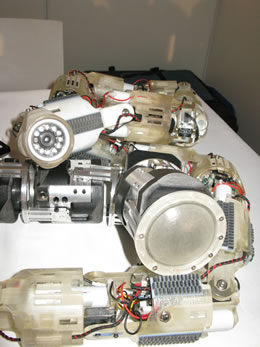

Researchers at the BioRobotics and BioMechanics Labortory (BRML) or Israel Technion are working on an improved, more robust and agile snake robot that will enhance the performance already demonstrated by an earlier BRML ‘robotic snake’ in 2009. Unlike the previous robot, that used a centralized processor to control the individual elements, the new model employs independent links built as common elements, each packing the logic and control processors, inertial sensors, servo actuators, power source, communications and sensors. The new robot will soon enter testing at the lab, and will eventually be tested by the Israel Defense Forces, as part of the Defense Research & Development Directorate’s urban terrain robotics program.
According to Lt Col. Gabi Dobresco, head of UGV and Advanced Concepts Branch at the Land Systems Division, DDR&D, the IDF is evaluating the snake robot as part of biologically-motivated structures dealing with challenging scenarios.
According to Dobresco, the robotic snake could be useful in urban and subterranean warfare, enabling the inspection and surveillance of sewage systems, narrow tunnels, or culverts, inaccessible by other systems. Another advantage of such robots is the fact that the entire robot acts as highly flexible arm having multiple Degrees Of Freedom (DOF).
The vision for snake robots, outlined by Dobresco includes highly maneuverable snake shaped robot that can maneuver through difficult terrain, ‘sneak’ stealthily inside buildings, use its sensors to scan their interiors. The robot will be able to carry disposable sensors that could be separated and left behind to monitor activity inside buildings. When suspicious activity inside buildings is detected, the stealthy robot will be able to identify specific targets while remain virtually unnoticed, and leave behind delayed activated explosive charges for employing lethal effect.

As primary sensors, the robot will be equipped with a thermal imager, miniature cameras or low-light TV sensors, and possibly laser scanners operating as laser radar (LADAR). As each of the links is embedded with cameras, the entire group provides redundant, instant multiple 360 degree view of the surrounding while mapping of indoor and subterranean areas by laser radar.
The new snake developed at BRML represents a major step in the DDR&D direction. Unlike the previous snake having a single DOF for each link, requiring 16 links to form sufficient flexibility and maneuverability, each of the new robot links has two joints, providing 2 DOF per link, hence, the number of links per ‘snake robot’ can be reduced to eight. The motors embedded in the new design have significantly higher moment /weight ratio. Each link is equipped with its own inertial system, reporting its relative position (to other elements), enabling the automatic motion and maneuver control to determine the position of the entire robot, and determine the next move to bring the robot closer to its objective, through difficult terrain and along the movement path selected for movement.
This 7kg prototype uses elements made of aluminum to meet the level of ruggedness required for field operation. However, for a production models Technion researchers expect the weight to drop by half, below four kg, as much of the aluminum parts with durable composite materials.
BRML displayed the new robot today at the Israeli Conference on Robotics (ICR) held today in Herzelia.
The video below depicts he first generation snake robot developed at the Technion lab.
















